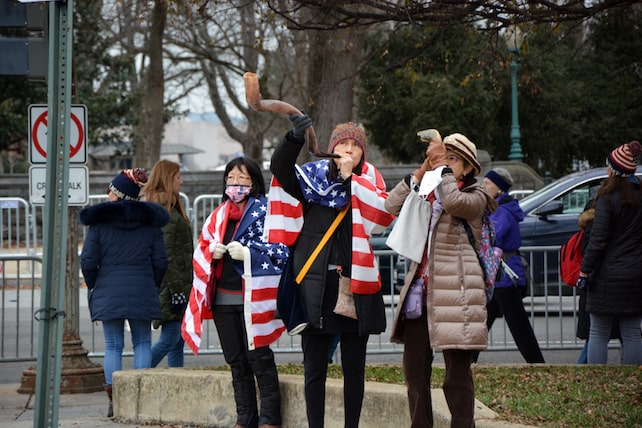(RNS) — The scene around the Capitol on Wednesday (Jan. 6) may look like a set piece from the “Ten Commandments” movie, as scores of Jericho March participants lift shofars to their lips.
Shofar blowing, an ancient Jewish ritual, is usually reserved for synagogue sanctuaries. On Rosh Hashana and Yom Kippur, Jews rise to hear a member of the congregation blow the ram’s horn to awaken their souls and prompt them to return to God.
But over the past few decades, the Jewish ritual has been overtaken by conservative evangelicals, charismatic and Pentecostal Christians.
While many of them are Christian Zionists who support the state of Israel and have worked to strengthen the bond between Christians and Jews, a newer generation of Christians has come to regard the shofar as a weapon of spiritual warfare, much as the bugle was once used in battlefields.
READ: As ‘Jericho Marchers’ descend on Washington, local faith leaders brace for attacks
Shofar blowing has become commonplace in many evangelical gatherings and political demonstrations far removed from any Jewish or Israel-related themes. Most recently, they’ve been used at worship leader Sean Feucht’s open-air concerts defying COVID-19 restrictions, at counterprotests opposing Black Lives Matter and in various Stop the Steal events, such as the one that took place on the steps of the Supreme Court on Dec. 12, and, of course, at the Jericho March this week. In these protests, the shofar is typically plastered with images of the American flag or red, white and blue colors.
“For the people who are coming to these marches, I don’t even know if they know (that the shofar) is a distinctly Jewish symbol or a Judaic-Christian symbol,” said Dan Hummel, research fellow in the history department at the University of Wisconsin-Madison who has written on evangelical and Jewish relations. “It’s a much more militaristic sign.”
In D.C. on Wednesday and other places around the country, the marchers are harking back to the biblical account of Israelites besieging the city of Jericho. In that story, an army of Israelites encircled the city seven times, blowing trumpets (in Hebrew, “shofars”) and shouting until the walls of the city came down and the city was won.
This week, the protestors blew shofars in the hopes Congress might invalidate enough votes to give President Donald Trump a second term—an unlikely outcome that would require a majority in both houses of Congress.
The shofar is harvested from the carcass of a ram’s horn or almost any other kosher animal; antelopes have particularly beautiful spiraling horns. They’re widely available online for as little as $30, though they can fetch much more.
Generations of Jews have found the plaintive wail of the shofar to be the highlight of the High Holiday services and for some, the entire Jewish liturgical year.
But beginning with the establishment of the state of Israel in 1948, which many evangelicals saw as the fulfillment of biblical prophecy, some Christians began warming to ancient Jewish practices, which they had previously rejected. The shofar was one; the Passover Seder, another. In many such gatherings, participants break into what they call “Davidic dance.”

